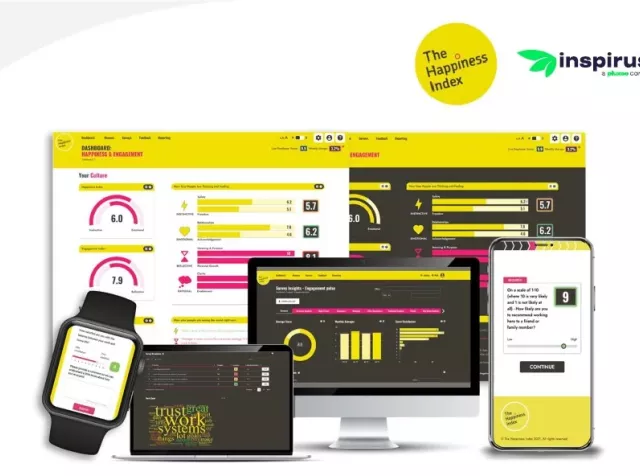
Navigating the Art of Constructive Peer Feedback: Building Stronger Collaborations
September 20, 2023
By Aspen Christopher
Most people would agree that constructive feedback is important for fostering a culture of continuous improvement, and building engagement, commitment, and continued contributions from employees. But what many people may not know is that feedback from director supervisors or managers isn’t the only kind of feedback that matters.
Most people would agree that constructive feedback is important for fostering a culture of continuous improvement, and building engagement, commitment, and continued contributions from employees. But what many people may not know is that feedback from director supervisors or managers isn’t the only kind of feedback that matters.
Feedback from peers can be impactful too! Constructive peer feedback can be a powerful way of boosting collaboration and camaraderie when done well.
Peer-to-peer recognition can foster a strong team culture, create community and belonging, and motivate employees to do better work. The broader the input, the more confidence employees have about the positive ways they’re contributing to organizational productivity and success.
That positive affirmation can have far-reaching effects on morale, productivity, and loyalty.
And, believe it or not, even constructive feedback can leave a positive impact.
The Power of Constructive Peer Feedback
While managers may have the power to provide employees with better pay and promotions, peers often have a deeper understanding and experience of employees’ strengths and weaknesses. After all, they work together on a regular basis. Even when not working physically together, they still have many encounters on a daily or weekly basis—and they depend upon each other to collaborate and work together to achieve mutual objectives.
A collaborative approach in an open and transparent work setting can enhance individual performance as well as team performance. Peers can be a very trusted source of insights and perspectives because of the relationships they have with each other—and the fact that there is no power differential at play.
Of course, providing constructive peer feedback—especially when the feedback may be perceived as negative or blaming—can make employees apprehensive. After all, they don’t want to risk damaging the positive relationships they’ve built with their peers. Fortunately, there are ways organizations can help employees feel less apprehensive and more confident about providing feedback to peers.
Cultivating the Right Mindset
It’s important for employees to cultivate the right mindset for giving constructive feedback. This is not about complaining, demeaning, or berating peers—it’s about having empathy and a growth mindset.
There is an important distinction to be made between constructive feedback and criticism. Constructive feedback focuses on the positive aspects of others’ behaviors or actions and offers specific suggestions for improvement. Criticism, on the other hand, is negative, judgmental, and focused on pointing out faults rather than working together to find mutual solutions.
A growth mindset is focused on working together as a team to achieve mutual objectives while supporting each other to improve and grow. It’s about fostering a positive and constructive dialogue that promotes personal and professional growth.
Empathy is a critical element of this mindset. Demonstrating respect for peers’ unique perspectives and personal feelings can help to build trust and rapport which is necessary for feedback to achieve desired results. So is the ability to pick the right time and place for delivering feedback!
Choosing the Right Time and Place
The right time to deliver constructive peer feedback is when the person you’re providing feedback to is most open to this input. That’s not likely to be when they’re in the midst of a major project or impending deadlines—or when they’ve returned from an extended vacation or sick leave. Providing feedback too late in the process is also not advised—it may be too late for the team member to do anything to remedy the situation.
The right place is also an important consideration. It’s important to deliver constructive feedback in private in a place that is free from distractions and where the recipient feels comfortable. So, it would be better to deliver the feedback in your peer’s private office than to ask them to come to yours. It’s also obviously important to avoid offering feedback in open or public spaces. Delivering constructive feedback during a team meeting is generally not appropriate.
For example:
- During a team meeting, a team member criticizes a colleague’s work on a recent project pointing out several mistakes and complaining about the negative impact the outcome had on them and the team overall. A better option: get together with the team member privately to share feedback, ask for their perspectives, and work together to determine how similar situations might be handled in the future.
- During a sales presentation, a team member challenges information their colleague has provided, questioning its accuracy. Here, again, this is feedback that is best delivered privately, and certainly not in front of a customer.
Ultimately, it’s important to choose a time when the recipient is likely to be the most open to the feedback and has the right mindset to receive it. Avoid delivering feedback when the person is angry, upset, or distracted.

As organizations deal with new challenges in retention, burnout, and digital workforces, it is essential to measure both happiness and engagement for cultural and business success, as well as the overall health of employees.
Framing Feedback Positively
When giving constructive peer feedback, it’s important to do so in a positive manner to ensure the recipient is open to input and motivated to make changes. When framing feedback, it’s important to:
Use ‘I” statements focused on your own specific observations instead of making assumptions or judgments about your peer. For instance: “I felt undermined when you challenged my work in front of our manager,” vs. “You were rude and arrogant to challenge my work.”
Offer specific suggestions for improvement, using concrete and positive examples. For instance: “The next time we have a presentation to make, let’s plan to get together at least a day before the presentation to rehearse and give each other feedback.”
The peer you’re providing feedback to is far more likely to take your comments to heart when you frame your feedback positively, focus on specifics, and avoid taking a blaming approach or tone.
Specificity and Actionability
Providing specific examples can help to support the feedback you’re giving to ensure your colleague understands your perspective. What were the specific behaviors or actions you observed that you’re providing feedback about? For instance: “When you fail to meet the deadlines we set up for a project, I’m put under pressure to make up time and my own work suffers. You missed three deadlines during this project, X, Y, and Z,” vs. “You miss too many deadlines.”
Specific examples help to clarify the feedback and make it more actionable. Using specific examples also demonstrates that your feedback is based on objective observations, not personal biases, or opinions.
Encouraging Dialogue and Collaboration
Providing constructive peer feedback isn’t a one-way conversation. It should be an opportunity for a peer-to-peer discussion. Encouraging dialogue and discussion is important to promote growth and maintain strong relationships.
For instance, Harvard Business Review points out that a partnership model can help maintain relationships while encouraging positive growth. This, they say, leads “to a more authentic and revealing feedback experience that fosters trust, flows with the rhythm of work, and sets the conditions for positive, lasting change.”
Following Up and Celebrating Progress
Finally, make sure to follow up and celebrate progress after you’ve shared feedback. Follow up to track progress and celebrate even small improvements. Continue to focus on a growth mindset designed to help peers succeed and promote shared accountability and mutual growth.
Again, keep in mind that these interactions should be conversations, not one-way dialogues. And, of course, as your peer’s performance or behavior improves you have the opportunity to offer positive feedback.
Conclusion
Constructive peer-to-peer feedback can be very powerful, but only if done appropriately. Employees need to be armed with information on how to provide effective constructive feedback, and when and where to provide it. They need to understand some key elements of framing feedback positively, using specific examples, and encouraging a two-way dialogue. It’s not easy. But it is important.
Following the advice provided here can help you and your employees do a better job of sharing constructive feedback, leading to a stronger work culture and better business results.
Connects can help to build a strong and cohesive employee community, offering the opportunity to give and receive feedback, and make critical connections. Learn more.




